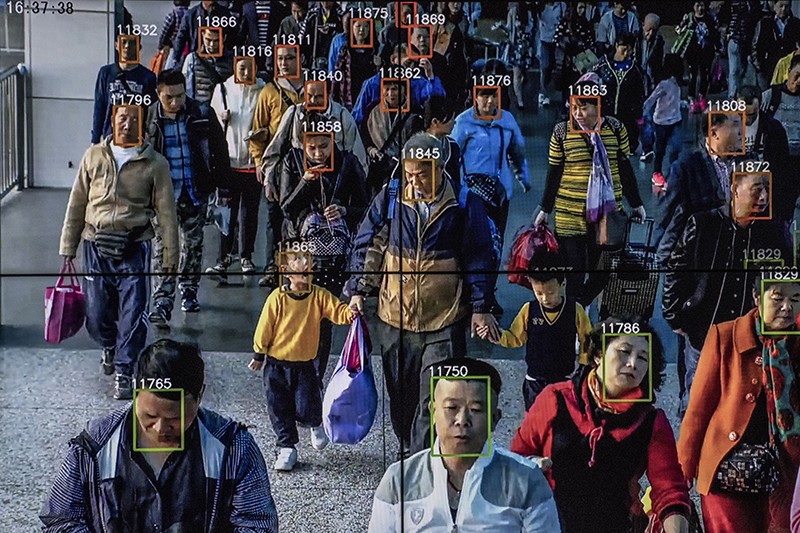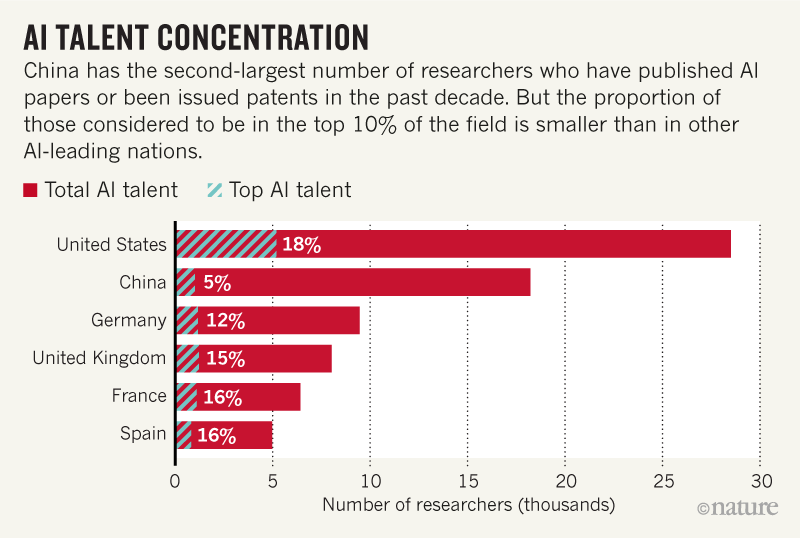
China not only has the world’s largest population and looks set to become the largest economy — it also wants to lead the world when it comes to artificial intelligence (AI).
In 2017, the Communist Party of China set 2030 as the deadline for this ambitious AI goal, and, to get there, it laid out a bevy of milestones to reach by 2020. These include making significant contributions to fundamental research, being a favoured destination for the world’s brightest talents and having an AI industry that rivals global leaders in the field.
As this first deadline approaches, researchers note impressive leaps in the quality of China’s AI research. They also predict a shift in the nation’s ability to retain homegrown talent. That is partly because the government has implemented some successful retainment programmes and partly because worsening diplomatic and trade relations mean that the United States — its main rival when it comes to most things, including AI — has become a less-attractive destination.
“If America loses its openness edge, then the country risks pushing AI talents right back into the arms of its competitors, including China,” says AI analyst Joy Dantong Ma at the Paulson Institute, a think tank in Chicago, Illinois, aimed at fostering US–China relations.
But observers warn that there are several factors that could stymie the nation’s plans, including a lack of contribution to the theories used to develop the tools underpinning the field, and a reticence by Chinese companies to invest in the research needed to make fundamental breakthroughs.
The country’s pursuit of AI domination is more than a symbolic race with the United States, say scientists. AI technologies promise advances in health care, transport and communications, and the nations that make fundamental breakthroughs in the field are likely to shape its future directions and reap the most benefits.
“There’s no doubt China sees AI as one of the critical technologies of this era and wants to match the United States,” says Jeffrey Ding, who studies China’s development of AI at the Future of Humanity Institute at the University of Oxford, UK.
The initiative unveiled in 2017, known as the New Generation Artificial Intelligence Development Plan, has spurred myriad policies and billions of dollars of investment in research and development from ministries, provincial governments and private companies.
Fundamental impact
China is well on its way to making a significant impact, according to an analysis of the most-cited AI papers indexed on the scholarly search engine Microsoft Academic. The analysis, by the Allen Institute for Artificial Intelligence in Seattle, Washington, found that China has steadily increased its share of authorship of the top 10% most-cited papers. It’s share peaked at 26.5% in 2018, not far behind the United States, at 29%, and whose share is declining. If this trend continues, China could overtake the United States in this measure next year. Other analyses show that average citations for AI papers by authors in China have been steadily increasing and are above the world average, but lower than for papers by US authors.

China also has world-leading companies in computer vision, speech recognition and natural language processing, including SenseTime, Unisound, iFLYTEK and Face++, says Zheng Nanning, director of the Institute of Artificial Intelligence and Robotics at Xi’an Jiaotong University.
But the country is still behind in shaping the core technological tools of AI. For instance, the open-source platforms TensorFlow and Caffe, developed by US academics and companies to design, build and train the sets of algorithms that enable computers to function more like the human brain, are widely used in industry and academia the world over. Yet PaddlePaddle, one of the major open-source platforms developed by Chinese company Baidu, is used mostly for the quick development of AI products, says Zheng.
China also lags behind in AI hardware, he says. Most of the world’s leading AI-enabled semiconductor chips are made by US companies such as Nvidia, Intel, Apple, Google and Advanced Micro Devices. “We also lack expertise in designing computing chips that can support advanced AI systems,” Zheng says.
Zheng predicts that it could take 5–10 years for China to reach the level of innovation in fundamental theories and algorithms occurring in the United States and the United Kingdom — but that it will get there.
Contributing to these fundamental theories and technologies will be key to China meeting its longer-term AI goals, says Kristin Shi-Kupfer, a political scientist at the Mercator Institute for China Studies, a think-tank in Berlin. Without progress in research to enable genuine breakthroughs in machine learning, there might be a ceiling to the growth that China can achieve in the field of AI, she says.
Time for talent
A factor that will be equally important to China’s progress — and in which there seems to be more promise — is the ability to hold onto talented researchers. According to the 2018 China AI Development Report, jointly written by academics and industry, by the end of 2017, China was home to the second-largest pool of AI scientists and engineers, about 18,200 people, ranking behind the United States, which had roughly 29,000. But China was just 6th in its number of top AI researchers — the most productive and highly cited authors, based on their h-index.

Ma says that computer scientists have typically trained in the United States and then stayed there to work for global technology companies.
There are signs that the situation is changing, however. AI institutes in China are trying to lure some of these researchers back to the mainland with high salaries. At Zheng’s robotics centre, for example, some of the professors are paid to 2–3 times more than others at the university, he says.
Zheng says that the centre also offers a more holistic evaluation system for staff than is found at many Chinese universities, which tend to reward high publication rates over other criteria. He has also implemented a hiring system that bypasses centralized university procedures and allows scientists to build teams of engineers quickly, and now runs undergraduate courses in AI.
The art of deployment
China’s plan to have globally leading AI companies by 2020 is also within reach, given the growing expertise of its three core tech companies, Tencent, Baidu and Alibaba, says Ding. “These companies have become global leaders in AI, although they are still not in the same tier as US companies, such as Google and Microsoft,” he says.
China also has at least ten privately owned AI start-ups valued at more than US$1 billion, including facial-recognition firm SenseTime, according to the research company CB Insights in New York.
Ma says that a big advantage for China is the size of its population, which creates a large potential workforce and unique opportunities to train AI systems, including large patient data sets for training software to predict disease. In February, Chinese researchers showed that their natural language processing system could diagnose common childhood conditions from electronic health records with comparable accuracy to experienced paediatricians1. The data set included nearly 600,000 children visiting a single hospital; accessing that amount of data would be difficult in many other countries.
AI law unto China
If China is to have global influence in the field of AI, it is also important that it has proper governance, says Ma, because this will allow researchers and companies in China to build the trust necessary to gain users across the world — and to build collaborations with researchers in other countries. Like many countries, China has begun the process of setting ethical principles for its development and use of AI. If Chinese companies don’t promise good governance, they won’t be allowed access to global data, says Ma. “It’s in their interest to play fair.”
In June, the National New Generation of Artificial Intelligence Governance Committee released eight principles to be observed by those working in AI development. These include harmony, fairness and justice, respect for privacy, safety, transparency, accountability and collaboration, and are similar to those released by the Organisation for Economic Co-operation and Development in May, says Ding.
But the ethical issues can vary from country to country. China, for instance, has attracted criticism from human-rights advocates over alleged uses of facial recognition technology to track members of the Uighur people, a predominantly Muslim community in Xinjiang. That said, Chinese authorities are not alone in using AI for law enforcement — the US Federal Bureau of Investigation uses face recognition technology as part of its investigations.
One of the key challenges faced by all groups is transparency in how algorithms make decisions. But there are no agreed standards for this, so China, like many countries, is still working out how to proceed. The European Union’s General Data Protection Regulation, which gives users the right to ask how an algorithm comes to its decision when it relates to their own lives, is an example of good AI governance, says Ma.
Source: https://www.nature.com


No comments:
Post a Comment